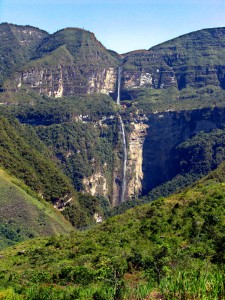23 November 2010
GOCTA, AMAZONES, PERU–From miles away you can see the cataract falling in a thin, silvery stream. The line bisects green jungle and is in two stages, falling to one shelf and then, much farther, to a base that cannot be seen until right upon it. In order to get right upon it a hike of several miles is necessary and that hike is mostly down. You hike down and down, into a green canyon, knowing all the while that to return will be up and up.
We began in the morning with a small group that included a Catalonian couple on a two-year trip around the world (we were, by this time, savvy to their non-Spaniardness), some Peace Corps girls, and a young woman and her mother from Washington State. After a bit of conversation, the usual traveler progression of where are you from to where have you been, we found that the Washington girl had spent time in Santa Rosa de Copan, Honduras, where I had lived for over a year. We spent a pleasant time then, hiking down the trail, speaking of places and people from that special city in the Western Highlands of Honduras, of sunsets on top of Hotel Elvir and coconut ice-cream.
I must confess that I didn’t pay much attention to the trail. It wasn’t an easy hike but somehow I was unaware of its almost completely downhill nature. Kristina, on the other hand, was well aware of what awaited us on the return trail. I did hear our guide say that the falls had not been measured until 2007. That they were known to the locals but unvisited, both because of some taboo and because the jungly canyon was infested with savage monkeys keen on preserving their turf through various monkey ways. But with the falls measuring and the opening of a trail the monkeys retreated farther into the wilderness and today, just a few years later, are rarely seen. By some counts the Gocta falls are the world’s third highest. Other counts place them at number five and still others way down at number 14. Angel Falls in Venezuela has long been determined to be the highest and it is said Tugela Falls in South Africa is number two.
Like the day before it was very hot and very dry. Kristina gamely carried the pack filled with water and food since I was burdened with cameras. Finally we reached the trail’s end and there was a black water mountain pool, surrounded by water-cut rock and fed by the falls which, so far below their peak, reached the bottom as a heavy mist. I changed into my suit in the lee of a large rock and entered the water. At first it was freezing but after a certain numbness set in it was, I believe, the most refreshing water I have ever felt.
The pool was not deep as the water rarely hits it directly and, for the most part, I could stand up as I crossed it towards the actual base of the falls. Of course I had to call out, “C’mon in, the water’s fine!” but Kristina decided to stay dry and contented herself with lazing in the sun. On the other side of the pool I found large, flat rock covered with fossils of bi-valves, proving again the fluid nature of the Andes–that regardless of its number on the list, that one of the world’s highest falls, thousands of feet above sea-level, was once at the bottom of the ocean.
From the base of the falls only the lower part of the falls are visible. Sunlight shimmers through the falling spray as it shifts in winds that one cannot feel down in the canyon. After a while, between looking up at the water and then down at the rocks at my feet, my brain put together the connection between the two and I decided the base of a very high falls in a geologically unstable land might be a bad place to spend too much time. Still, I wish we had had longer to explore and it was all too soon that our group began the hike back. It began well enough. I was refreshed from my swim, but soon the heat of the day and the constant struggle up began to take their toll. The male Catalonian had ridden a horse in, claiming a twisted ankle though my unworthy inner voice blamed it on avoidable chubbiness and grumbled that there was a Spaniard-by-another-name, riding a horse, conquistadoring everything in sight. On the way back I began to think him a rather sensible fellow. I put one foot in front of another, trying not to curse at the corner of every switchback that led up and up and every upwards, taking no real comfort in the fact that such a hike would quite literally kill most of my desk-bound peers.
Kristina was looking dangerously red and, on the suggestion of the guide, ordered up a horse by radio. We kept climbing. After a while the horse came and she mounted the beast and almost immediately regained her normal pale color. I trudged on despite offers of equestrian assistance. Just about the point where I was about to take a long break another guide, going our way, offered the use of horse meant for someone else farther down the trail. I figured there was no shame in taking an available mount and rode it for a critical 20 minutes that allowed me to recover my breath and cool off.
It usually seems that, even if difficult, the return journey seems shorter than the trek in. This was not one of those cases and Kristina and I both agreed over a cold Inca Cola that if we ever return to Gocta, that it will be a mounted trip from beginning to end…





One Comment